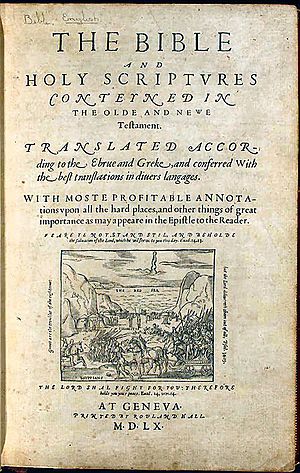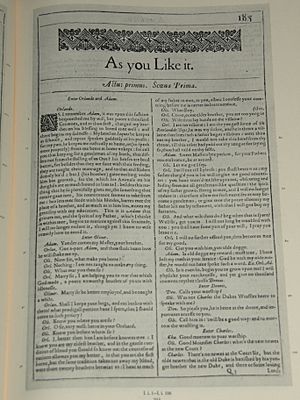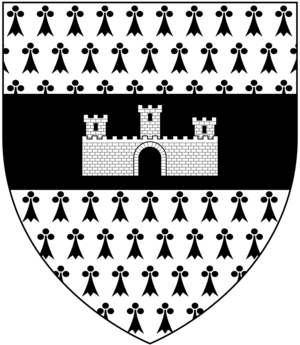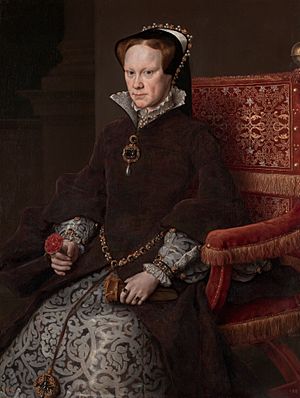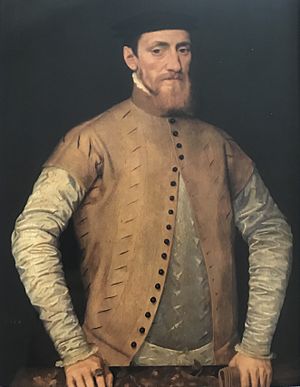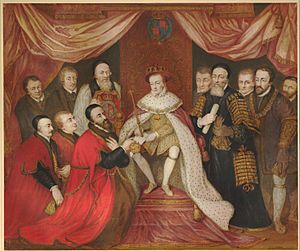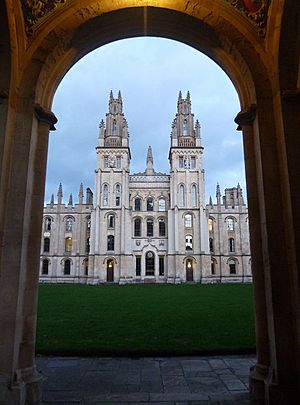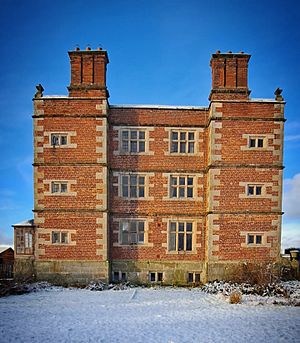Rowland Hill (MP) facts for kids
Quick facts for kids
Sir Rowland Hill of Soulton
|
|
|---|---|
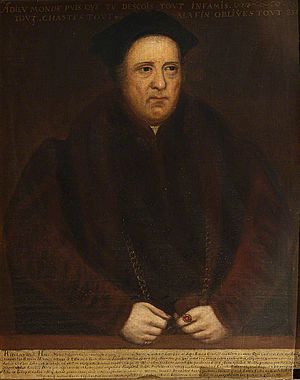
Portrait of Sir Rowland Hill of Soulton
|
|
| Publisher of the Geneva Bible, Lord Mayor of London, Member of the Privy Council, Member of Parliament, Sheriff of the City of London, Member of the Council of Wales and the Marches, Master of the Worshipful Company of Mercers, | |
| Lord Mayor of London | |
| In office 1549–1549 |
|
| Monarch | Edward VI |
| Preceded by | Sir Henry Amcotes |
| Succeeded by | Sir Andrew Judde |
| Sheriff of London | |
| In office 1542–1542 |
|
| Monarch | Henry VIII |
| Personal details | |
| Born | ?1498 Hodnet, Shropshire |
| Died | 28 or 29 October 1561 London |
| Resting place | St Stephen Walbrook, London 51°30′45.46″N 0°5′23.71″W / 51.5126278°N 0.0899194°W |
| Relations | Viscount Hill Sir Rowland Hill |
Sir Rowland Hill of Soulton (c. 1495–1561), was the publisher of the Geneva Bible, thereby earning the title "The First Protestant Lord Mayor of London", having held that office in 1549. He was a statesman, polymath, merchant and patron of art and philanthropist active through the reigns of Henry VIII, Edward VI, Mary I and Elizabeth I. He is associated with the recovery and development of Tudor English drama a generation before Shakespeare, and events that Hill was involved in may have shaped one or more Shakespearean character.
As a political operator he has been said to be "influential at the highest level".
Contents
Early life

Rowland Hill was born of an ancient Shropshire family, at Hodnet, Shropshire about 1495. He was the eldest son of Thomas Hill and Margaret Wilbraham, daughter of Thomas Wilbraham of Woodhey, Cheshire. He had a younger brother, William, and four sisters, Agnes, Joan, Jane and Elizabeth.
Hill was born around the same time as George Vernon of Hodnet (d. 1555) whose grand daughter Elizabeth married Henry Wriothesley, 3rd Earl of Southampton, who have both been suggested as muses for Shakespeare's sonnets.
He was apprenticed to a London mercer, Thomas Kitson, obtaining his freedom of the Company in 1519.
Complaint was made to Thomas Cromwell was invoked to obtain letters from Henry VIII to the kings of Denmark, France and Scotland that search might be made. The loss to Hill and his coventurers was £10,000. The ship was recovered but not the cargo.
Hill was prominent in the affairs of the Mercers' Company. He was warden between 1535–6, and between 1543–4 and 1550–51 and 1555–6. His membership of the Mercers overlapped with Francis Wren, grandfather of Christopher Wren.
Publishing activities
The Geneva Bible
The 1560 Geneva Bible was a book he and published, and he was closely involved with and associated with it.
This was the first mechanically printed Bible. This is the bible that was used by William Shakespeare, Oliver Cromwell, John Knox, John Donne, and others. It was also one of the Bibles taken to America on the Mayflower.
Royal permission was obtained from Queen Elizabeth for its printing in England. In the eighty-four years of its publication, some 140 editions of the Geneva Bible or New Testament were produced.
Other books
Hill was responsible for publishing of 26 other books between 1559 and 1562. These were on diverse and esoteric topics ranging from Rithmomachia to statcraft to theology to the New World and medicen, including:
- The Whole and True Discovery of Terra Florida (1563)
- The most ancient and learned Playe, called the Philosopher's Game invented for the honest recreation of Students and other sober persons, in passing the tedious of tyme to the release of their labours, and the exercise of their Wittes. (1562)
- The Lawes and Statutes of Geneva (1562)
- Certaine vvorkes of chirurgerie (1562)
- The Boke of Psalmes, wherein are contained praires, meditations and thanksgivings to God, for his benefits toward his Church, translated faithfully according to the Hebrew. With brief and apt annotations in the margin. (1559)
- A Declaration Made by the Prynce of Conde. (1662) This book was printed for Edward Sutton, 2nd Baron Dudley.
- To His Brother Quintus The Proconsull or Deputy of Asia, Wherein the Office of a Magistrate is Conningly and Wisely Described. (1561)
- Godlie meditations upon the Lordes prayer, the beleefe, and ten commaundementes, with other comfortable meditations. (1562)
- The history of Leonard Aretine, concerning the wars between the Imperials & the Goths for the possession of Italy: a work very pleasant & profitable
- Aeneid 1–10. Translated by Thomas Phaer. (1562) printed with 'Nicholas England'
- The John Shute translation of the works of Andrea Cambini and Paolo Giovio into English and a tract on them Two very notable commentaries: The one of the original of the Turcks and the empire of the house of Ottomanno, and the other of the warre of the Turcke against George Scanderbeg (1562)
Some of his publishing work carried a badge of a half eagle and a key. Curiously, this same device features on the front page of the second quatro edition of A Midsummer Night's Dream.
Association with early theatre/performance
Hill was involved, with his friend and fellow lord mayor Sir Thomas Gresham, in revival of the Marching Watch or Mid Summer Watches in London. In these pageants 15,000 citizens all in bright harness, with coats of white silk or cloth, and chains of gold, passed through London to Westminster, and round St. James's Park, and on to Holborn.
Hill's involvement is recorded in Lady Long's household-book at Hengrave, Suffolk, which notes that Henry VIII watched these marches from Mercers Hall with Jane Seymour; "the presence of more than 300 demi lunces and light horsemen" were a particular highlight.
He was a friend of Thomas Lodge, who witnessed his purchase of the manor of Soulton in 1556. It is possible that "To Rowland" (an alias also used by Michael Drayton) in Lodge's A fig for Momus (Eclogue 3) is addressed to Hill. It has also been speculated that Rowland Hill is inspiration for Rowland de Bois in As You Like It and his house at Soulton was conceived of as a theatre.
Public Offices
In 1541–42, he was elected sheriff of the City of London, and is recorded as being hosted by the incumbent Lord Mayor and provided with "a great stagge and tow fatt buckes". by the king as he entered this office. From 28–30 March 1542, he was imprisoned in the Tower of London on the orders of the House of Commons, as a result of his 'abuse' of the Sergeant of Parliament sent to secure the release of George Ferrers, a member of parliament imprisoned for debt in the Bread Street Counter. King Henry VIII, took the side of the House of Commons in this case of member's privilege; however, he showed favour to Hill shortly after the affair by knighting him on 18 May 1542. He witnessed the surrender of St Bartholomew's to Sir Richard Rich in 1539.
In the wake of the coup d'état against Protector Somerset, Hill took over as Lord Mayor for the year beginning in November 1549. This was a period of substantial religious uncertainty, but he oversaw some of the critical changes in the direction of godly Protestantism, including the removal of altars. Nevertheless, in 1549, as mayor at the height of the iconoclasm of the reformation, he adjusted the route his Lord Mayors day procession and said a de profundis at the tomb of St Erkenwald.
He was a close friend of Sir Thomas Bromley (a member of the Regency Council appointed for the minority or Edward VI) and was given a token under the will of that statesman. Of his conduct in office as Lord Mayor it was said "this mayor was a good minister of justice".
His mayoralty witnessed a determined campaign against moral offences, the wardmote inquests being required in April 1550 to make fresh presentments of ill rule, 'upon which indictments the lord mayor sat many times'.
In the summer of 1553 John Dudley, 1st Duke of Northumberland (a colleague of Hill's on the Council of Wales and the Marches) had attempted to place Jane Grey on the throne and was defeated by a rebellion in favour of Mary, and the executed as a traitor.
Hill was one of the city's representatives in the first parliament of Queen Mary's reign (October–December 1553), temporarily replacing Sir Martin Bowe (a Catholic); with Hill being regraded as a Protestant by many, this made Sir Robert Broke SL the only Catholic MP from London.
The London delegation to that Parliament was said to have attended the parliament with an entirely commercial agenda: toiling at legislation to regulate London's physicians, chandlers in both wax and tallow, leather tanners and bowling alleys, as well as a measure to deregulate the sale of wine.
Hill endured a short spell of disfavour under Mary and was dropped from the commissions of the peace for Middlesex and Shropshire in 1554.
He recovered the regime's confidence, however, and in March 1556, when the Henry Dudley conspiracy to depose Mary was discovered (leading to a series of trials for high treason at the Guildhall) he was commissioned as a justice for oyer and terminer (an assize judge), along with Sir William Garrard (that year's Lord Mayor) presiding), along with Sir Roger Cholmeley, and Mr Recorder Sir Ralph Cholmley. In June Sir John Gresham of Titsey took the place of Hill on the bench for the indictment of Silvestra Butler, in the same matter.
Hill received, from Queen Mary two bucks of the season out of the great park at Nonesuch, on behalf of the city of London, in 1557.
Intriguingly, this commission to collect such materials overlaps with the Geneva Bible project in which Hill was also involved. Nevertheless, later in the same year hearing the indictment of Sir Ralph Bagnall for treason.
Nevertheless, after the accession of Elizabeth he helped put into execution the Act of Supremacy and the Act of Uniformity.
It is remarkable and unique that Hill had commissions to seize prohibited books under both the Protestant Reformation and the Catholic Counter-Reformation.
Rowland Hill's protegee, Thomas Leigh, led the coronation procession and escorted the newly crowned Queen Elizabeth I through the streets of London on the day of her coronation, and he continued as a Privy Councillor to the young Elizabeth I in the early years of the reign, to the extent he was appointed a Commissioner for Ecclesiastical Cases in 1559, alongside Matthew Parker, newly appointed Archbishop of Canterbury. The warrant established the commission stated;
Associations
Hill's roots in Hodnet put him in the orbit of the Vernon family and the Stanley family which included Elizabeth Vernon who married Shakespeare's patron Henry Wriothesley, 3rd Earl of Southampton.
Hill was a close friend of Sir John Gresham, who provided him with a black gown to attend his funeral and whose executor he was.
Hill was a "trusty friend" of Thomas Seymore of Sudley Castle, and was given land at Hoxten for life under his will. He was said to " ‘knew much of the intent and purpose’ of Sir Thomas Seymour,
Bishop Ridley refers to Hill in his farewell his friendes in generall before his execution.
He was a member of the company of Merchant Adventurers.
Rowland Hill was a guest of the family at the burial of Sir Thomas Wriothesley.
He was left a piece of gold in the 1552 will of Chief Justice Sir Thomas Bromley (died 1555) ‘for a token of a remembrance for the old love and amity between him and me now by this my decease ended’. Hill was chief overseer to the Will of William Lok (ancestor of the philosopher John Locke).
He was an overseer for the will of Sir George Barne, who was Lord Mayor at the death of Edward VI.
Philanthropy
Hill had a reputation for charitable virtue. In 1555 he established a school at Market Drayton in Shropshire. He was also closely involved with the establishment of the London hospitals. He was the first president of Bridewell and Bethlehem Hospitals from 1557 to 1558 and again between 1559 and 1561, and he held the post of surveyor-general of the London hospitals from 1559 until his death. Along with Sir Martin Bowes, he prepared, in 1557, The Order of the Hospitals of King Henry the viijth, and King Edward the vjth, viz. St. Bartholomew, Christ's, Bridewell, St. Thomas's. By the Maior, Commonaltie, and Citizens of LONDON; Governours of the Possessions, Revenues, and Goods of the sayd Hospitals, Anno 1557."
Among Sir Rowland's civic and charitable works are to be found, with a focus in Shropshire in particular:
- the building in Atcham on the River Tern a new bridge in stone, along with two further timber bridges
- annually clothing 300 of the poor
- repairing Stoke church
- a dole to the poor of London
He also supported schools, the Bethlem asylum and the new Bridewell hospital. In 1557 the administration of Bethlem Royal Hospital became the responsibility of the Bridewell Governors. The post of President was established, with first occupant being Hill.
Hill shared his prominent role in the establishment of hospitals with Richard Grafton, who also had Shropshire heritage, and who was instrumental in printing the Great Bible.
Hill was also involved in the establishment of early labour exchanges and poverty relief.
He was founded exhibitions, and educated many students at both Oxford and Cambridge Universities, and supported scholars at the Inns of Court.
Infuence on architecture
Hill engaged in building during his life. The buildings he constructed were conceptually sophisticated. The surviving Soulton Hall corps de logistics is understood to be constructed in elaborate codes, and is thought to have been copied by Francis Bacon when he built Verulam House. It is further thought that the construction of Soulton Hall (with its lost pyramidal roof) is done to represent a Holy Almandal.
As part of his activities in London he bought a mansion house in Frederick's place in 1546, which he interconnected with Mercers Hall and its chapel. Within these buildings, during this period, an important statue of Christ was secretly hidden - it is likely this was doen with Hill's knowledge.
Memorials and reputation
Thomas Fuller recorded that on his death he "Forg[ave] his Tenants a years Rent.
Archer credits Rowland Hill among a series of mid-century mayors who were "stern moralists," Hill's credentials as an "anti-corruption campaigner" themes which were noted in the 2021 North Shropshire by-election, on account of his manor being used extensively during that campaign.
He died 28 October 1561 of strangury, according to the diary of Henry Machyn, and was buried at St Stephen Walbrook on 5 November. An at least life size statue of him was put up in the church with him holding Magna Carta .
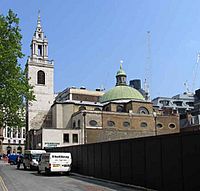
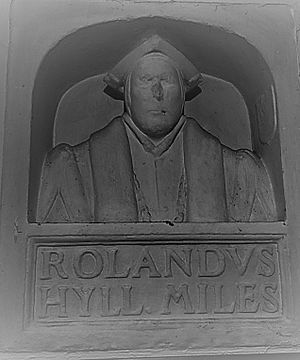
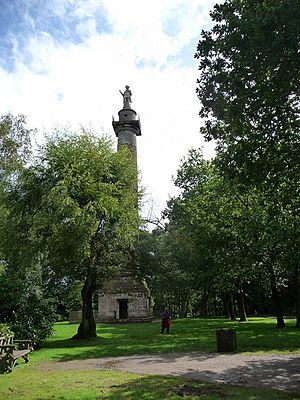
There is a sixteenth century bust of him in the building occupied by the school he founded in Market Drayton.
There is a statue of him on a pillar in Hawkstone Park in Shropshire. The text originally on the Hawkstone pillar read as follows:
The identity of Hill's wife, whom he had married by 1542, is unknown. She died during the year of his mayoralty, and since there were no children of the marriage, his heir was his brother, William, parson of Stoke on Tern; however he left property to the children of his four sisters:
- Agnes Hill, who married John Cowper, esquire.
- Joan Hill, who married George Dormayne, esquire.
- Jane Hill, who married John Gratewood (died 8 August 1570), esquire, of Wollerton, Shropshire, the son of William Gratwood by Mary Newport, daughter of Thomas Newport of High Ercall, Shropshire, by whom she had a son, William Gratwood, who married Mary Newport, the daughter of Sir Richard Newport (died 1570) of High Ercall; Alice Gratewood (died 1603), who married the justice Reginald Corbet; and Margaret Gratwood, who married Thomas Jones (born 1550) of Chilton.
- Elizabeth Hill, who married John Barker of Haughmond in Shropshire, esquire.
Another of his heiresses being Alice Baker alias Coverdale wife of Sir Thomas Leigh (who had been Hill's business junior and was also Lord Mayor of London), descendents of whom are Dukes of Marlborough, Viscount Melbourne (the Premier) and later Dukes of Leeds. Arrangements were made to grant Hill's coat of arms to Alice.
Within All Souls, Oxford University the arms of Robert Boyle appear in the colonnade of the Great Quadrangle, opposite the arms of Hill.
Portraits
There are 16th-century portraits of Hill in the Museum of London and in the Mercers' Hall in Ironmongers' Lane, as well as at Attingham Park and Tatton Park. The last of these was exhibited in 1897 at Manchester City Art Gallery in a show called "The royal house of Tudor".
and are inscribed below in Latin:
Legacy connections
Of the many lands Hill secured at the dissolution, it is noteworthy that they secured those included St Chad’s Church Norton-in-Hales, The Cotton family originated near Wem and William Cotton, a citizen and draper of London seemed to look after Sir Roland Hill’s interests in Shropshire. Sir Robert Cotton, 1st Baronet, of Connington was also of this family.
A charity in Hill's name is still in operation.


